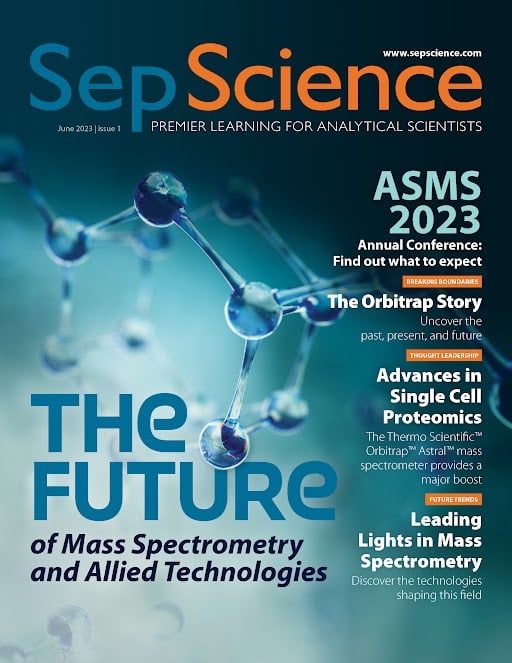Scientists are leveraging a range of tools to tackle escalating IMS-MS data processing challenges.

Ion mobility spectrometry–mass spectrometry (IMS-MS) is an increasingly popular tool, particularly in the omics fields such as proteomics and metabolomics. However, the large and complex data sets generated by IMS-MS applications present significant challenges in terms of data processing and analysis.
One scientist who is all too familiar with these challenges is Erin Baker, a bioanalytical chemist and Associate Professor at the University of North Carolina at Chapel Hill. Baker was awarded the 2022 ASMS Biemann Medal, recognized for her work in the application and development of IMS-MS technologies. Key achievements in her impressive career include significant contributions to improving drift tube IMS (DTIMS) platforms and leveraging techniques to enable high-throughput and highly sensitive measurements.
Much of Baker's recent work revolves around the various omics, areas that produce vast amounts of data. This has led to some of her other notable achievements, including creating one of the first collision cross section (CCS) databases for metabolites and xenobiotics and developing a cheminformatic toolbox dubbed SCOPE (short for structural-based connectivity and omic phenotype evaluations). SCOPE enables scientists to assess and visualize lipidomic associations in clinical and environmental studies.
We spoke to Baker to find out about some of the data processing challenges she's facing in her work and how those challenges are being overcome.
Could you provide some background on the types of IMS-MS projects you've been involved with in recent years?
We have become involved in many different omic analyses, from proteomics to lipidomics, and we are really getting into exposomics now. The exposomic studies allow us to investigate the presence of xenobiotic molecules and their transformation products that cause changes in the endogenous molecules in your body. However, performing multi-omic studies becomes highly complex since we must use multiple methods to analyze the different molecular types. Furthermore, we perform multi-dimensional separations, which means we combine a chromatography step with ion mobility spectrometry and mass spectrometry to obtain information on the polarity, size, and mass of the detected features. Thus, multi-omics and multi-dimensional analyses can be complex to understand, so figuring out how to analyze all the data and fully understand what is going on is a huge component of our research. Currently, we often perform each omic analysis individually, try to find out what was most significant, and then bring the omic studies together. However, that is not the best way to do things, and it would be great to understand how the different molecules are changing up and down in the various studies. Therefore, we are trying to use machine learning techniques to bring the multiple omics together and evaluate the different features at the same time.
Are there analytical tools available for you to process all of the data you produce?
There is still a lot of work to be done in this area. I am lucky because many of my students are interested in coding, so we try to find current open-source tools that meet some of our needs and then modify them. However, if nothing exists, we write the tools ourselves or work with others in the same area. If we create a new tool, we try to release it as quickly as possible on GitHub so that others can use and modify it.
Are there any particular tools shining right now?
We are using Skyline for our targeted data analysis so that we can manually check each identification and possible biomarker. Skyline has been fundamental in our studies as it enables us to validate our identification. Plus, working with the Skyline software team has been amazing, and they have helped us add new analysis capabilities that we could not do on our own. We also employ pmartR from Pacific Northwest National Laboratory (PNNL) and MetaboAnalyst for our statistical analyses. And we are looking into other ways to carry out the non-targeted analyses. Much of that has so far involved more of our open source, homebuilt software where we incorporate information such as ion mobility collision cross sections and masses and mass defects for the precursor and fragment ions for the analyses.
Do you see work being done to mitigate potential future challenges in IMS-MS data processing?
There will certainly continue to be challenges in terms of all the data we can create and what we can do with it. Many people are pushing our capabilities in data processing, such as those creating large standard libraries, building machine learning tools, and growing molecular networking capabilities. Social media is also playing a large role in advancing the field as it provides an open forum for researchers to ask questions and experts to weigh in quickly or point people to resources that they might not have known existed. Since information sharing is key for our field to address and conquer the difficult clinical and environmental problems we study, it is exciting to imagine what advances may be made in the next decade.
Baker is also noted for her role in helping establish Females in Mass Spectrometry (FeMS), an initiative that provides a support network for women who work in the field of mass spectrometry. FeMS was created in early 2019 and has already grown to a group of more than 5,000 to date.
 This article is featured in our June publication, 'The Future of Mass Spectrometry and Allied Technologies.' Download the PDF to discover the latest trends in mass spectrometry, including insights from some of the leading experts in the field.
This article is featured in our June publication, 'The Future of Mass Spectrometry and Allied Technologies.' Download the PDF to discover the latest trends in mass spectrometry, including insights from some of the leading experts in the field.




